Space station
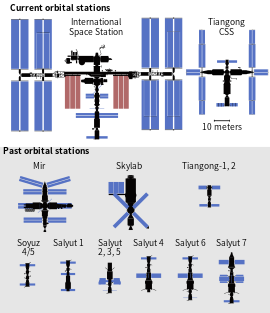

Aspace station(ororbital station) is aspacecraftwhich remainsin orbitandhosts humansfor extended periods of time. It therefore is anartificial satellitefeaturinghabitation facilities.The purpose of maintaining a space station varies depending on the program. Most often space stations have beenresearch stations,but they have also servedmilitaryorcommercial uses,such as hostingspace tourists.
Space stations have been hosting the only continuouspresence of humans in space.The first space station wasSalyut 1(1971), hosting the first crew, of the ill-fatedSoyuz 11.Consecutively space stations have been operated sinceSkylab(1973) and occupied since 1987 with theSalyutsuccessorMir.Uninterrupted occupation has been sustained since the operational transition from the Mir to theInternational Space Station(ISS), with its first occupation in 2000.
Currently there are two fully operational space stations – the International Space Station (ISS) andChina'sTiangongSpace Station(TSS), which have been occupied since October 2000 withExpedition 1and since June 2022 withShenzhou 14.The highest number of people at the same time on one space station has been 13, first achieved with the eleven day docking to the ISS ofthe 127thSpace Shuttlemission in 2009. The record for most people on all space stations at the same time has been 17, first on May 30, 2023, with 11 people on the ISS and 6 on the TSS.[1]
Space stations are most oftenmodular,featuringdocking ports,through which they are built and maintained, allowing the joining or movement of modules and the docking of other spacecrafts for the exchange of people, supplies and tools. While space stations generally do not leave their orbit, they do featurethrustersforstation keeping.
History
[edit]Early concepts
[edit]The first mention of anything resembling a space station occurred inEdward Everett Hale's 1868 "The Brick Moon".[2]The first to give serious, scientifically grounded consideration to space stations wereKonstantin TsiolkovskyandHermann Oberthabout two decades apart in the early 20th century.[3]
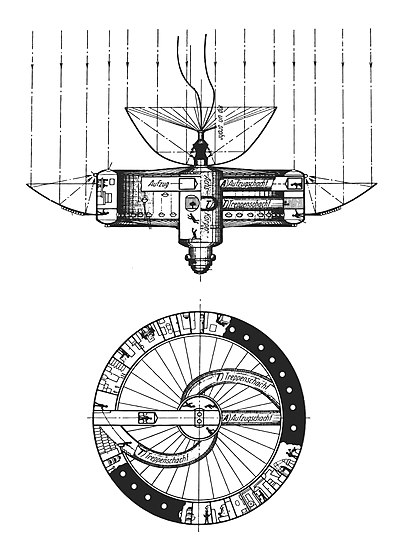
(Legend:Achs-Körper:axlebody.Aufzugschacht:elevatorshaft.K:electric cable to an external observatory.Kondensatorrohre:condenser pipes.S:airlock.Treppenschacht:stairwell.Verdampfungsrohr:boiler pipe).
In 1929,Herman Potočnik'sThe Problem of Space Travelwas published, the first to envision a "rotating wheel" space station to createartificial gravity.[2]Conceptualized during theSecond World War,the "sun gun"was a theoreticalorbital weaponorbiting Earth at a height of 8,200 kilometres (5,100 mi). No further research was ever conducted.[4]In 1951,Wernher von Braunpublished a concept for arotating wheel space stationinCollier's Weekly,referencing Potočnik's idea. However, development of a rotating station was never begun in the 20th century.[3]
First advances and precursors
[edit]The first human flew to space and concluded the first orbit on April 12, 1961, withVostok 1.
TheApollo programhad inits early planninginstead of alunar landinga crewedlunar orbitalflight and an orbital laboratory station in orbit of Earth, at times calledProject Olympus,as two different possible program goals, until theKennedy administrationsped ahead and made the Apollo program focus on what was originally planned to come after it, the lunar landing. The Project Olympus space station, or orbiting laboratory of the Apollo program, was proposed as an in-space unfolded structure with theApollo command and service moduledocking.[5]While never realized, the Apollo command and service module would performdocking maneuversand eventually become a lunar orbiting module which was used for station-like purposes.
But before that theGemini programpaved the way and achieved the firstspace rendezvous(undocked) withGemini 6andGemini 7in 1965. Subsequently in 1966Neil Armstrongperformed onGemini 8the first ever space docking, while in 1967Kosmos 186 and Kosmos 188were the first spacecrafts that docked automatically.

In January 1969Soyuz 4andSoyuz 5performed the first docked, but not internal, crew transfer, and finally in MarchApollo 9performed the first ever internal transfer of astronauts between two docked spaceships.
Salyut, Almaz and Skylab
[edit]
In 1971, theSoviet Uniondeveloped and launched the world's first space station,Salyut 1.[6]TheAlmazandSalyut serieswere eventually joined bySkylab,Mir,andTiangong-1andTiangong-2.The hardware developed during the initial Soviet efforts remains in use, with evolved variants comprising a considerable part of the ISS, orbiting today. Each crew member stays aboard the station for weeks or months but rarely more than a year.
Early stations were monolithic designs that were constructed and launched in one piece, generally containing all their supplies and experimental equipment. A crew would then be launched to join the station and perform research. After the supplies had been consumed, the station was abandoned.[6]
The first space station wasSalyut 1,which was launched by theSoviet Unionon April 19, 1971. The early Soviet stations were all designated "Salyut", but among these, there were two distinct types: civilian and military. The military stations,Salyut 2,Salyut 3,andSalyut 5,were also known asAlmazstations.[7]
The civilian stationsSalyut 6andSalyut 7were built with two docking ports, which allowed a second crew to visit, bringing a new spacecraft with them; theSoyuz ferrycould spend 90 days in space, at which point it needed to be replaced by a fresh Soyuz spacecraft.[8]This allowed for a crew to man the station continually. The AmericanSkylab(1973–1979) was also equipped with two docking ports, like second-generation stations, but the extra port was never used. The presence of a second port on the new stations allowedProgresssupply vehicles to be docked to the station, meaning that fresh supplies could be brought to aid long-duration missions. This concept was expanded on Salyut 7, which "hard docked" with aTKS tugshortly before it was abandoned; this served as a proof of concept for the use of modular space stations. The later Salyuts may reasonably be seen as a transition between the two groups.[7]
Mir
[edit]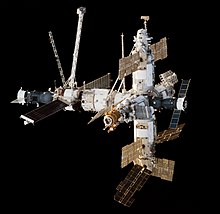
Unlike previous stations, the Soviet space stationMirhad amodular design;a core unit was launched, and additional modules, generally with a specific role, were later added. This method allows for greater flexibility in operation, as well as removing the need for a single immensely powerfullaunch vehicle.Modular stations are also designed from the outset to have their supplies provided by logistical support craft, which allows for a longer lifetime at the cost of requiring regular support launches.[9]
International Space Station
[edit]
The ISS is divided into two main sections, theRussian Orbital Segment(ROS) and theUS Orbital Segment(USOS). The first module of the International Space Station,Zarya,was launched in 1998.[10]
The Russian Orbital Segment's "second-generation" modules were able to launch onProton,fly to the correct orbit, and dock themselves without human intervention.[11]Connections are automatically made for power, data, gases, and propellants. The Russian autonomous approach allows the assembly of space stations prior to the launch of crew.
The Russian "second-generation" modules are able to be reconfigured to suit changing needs. As of 2009,RKK Energiawas considering the removal and reuse of some modules of the ROS on theOrbital Piloted Assembly and Experiment Complexafter the end of mission is reached for the ISS.[12]However, in September 2017, the head of Roscosmos said that the technical feasibility of separating the station to form OPSEK had been studied, and there were now no plans to separate the Russian segment from the ISS.[13]
In contrast, the main US modules launched on theSpace Shuttleand were attached to the ISS by crews duringEVAs.Connections for electrical power, data, propulsion, and cooling fluids are also made at this time, resulting in an integrated block of modules that is not designed for disassembly and must be deorbited as one mass.[14]
TheAxiom Orbital Segmentis a planned commercial segment to be added to the ISS starting in the mid-2020s. Axiom Space gained NASA approval for the venture in January 2020. Up to three Axiom modules will attach to the International Space Station. The first module, Hab One, is expected to be launched at the end of 2026[15]and will be docked to the forward port ofHarmony,requiring relocation of thePMA-2.Axiom Space plans to attach up to two additional modules to its first core module, and send private astronauts to inhabit the modules. The modules would later detach into theAxiom Stationin a manner similar to Russia's proposed OPSEK.[16]
Tiangongprogram
[edit]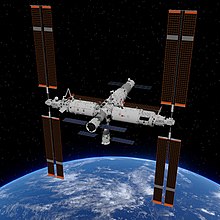
China's first space laboratory,Tiangong-1was launched in September 2011.[17]The uncrewedShenzhou 8then successfully performed an automatic rendezvous and docking in November 2011. The crewedShenzhou 9then docked with Tiangong-1 in June 2012, followed by the crewedShenzhou 10in 2013.[citation needed]
According to theChina Manned Space Engineering Office,Tiangong-1reenteredover the SouthPacific Ocean,northwest ofTahiti,on 2 April 2018 at 00:15 UTC.[18][19]
A second space laboratoryTiangong-2was launched in September 2016, while a plan forTiangong-3was merged with Tiangong-2.[20]The station made a controlled reentry on 19 July 2019 and burned up over the South Pacific Ocean.[21]
TheTiangongSpace Station(Chinese:Thiên cung;pinyin:Tiāngōng;lit.'Heavenly Palace'), the first module of which was launched on 29 April 2021,[22]is in low Earth orbit, 340 to 450 kilometres above the Earth at an orbital inclination of 42° to 43°. Its planned construction via 11 total launches across 2021–2022 is intended to extend the core module with two laboratory modules, capable of hosting up to six crew.[23][24]
Planned projects
[edit]These space stations have been announced by their host entity and are currently in planning, development or production. The launch date listed here may change as more information becomes available.
| Name | Entity | Program | Crew size | Launch date | Remarks |
|---|---|---|---|---|---|
| Lunar Gateway | Artemis | 4
|
2025[25] | Intended to serve as a science platform and as a staging area for the lunar landings ofNASA'sArtemis programand follow-onhuman mission to Mars. | |
| Axiom Station | International Space Station programme | TBD
|
Late 2026[26] | Eventually will detach from the ISS in the early 2030s and form a private, free flying space station for commercial tourism and science activities. | |
| Russian Orbital Service Station |
Russia's next generation space station. | TBD
|
2027[27] | With Russia leaving the ISS programme sometime after 2024, Roscosmos announced this new space station in April 2021 as the replacement for that program. | |
| Starlab | Private | 4
|
2028[28] | "Commercial platform supporting a business designed to enable science, research, and manufacturing for customers around the world."
While originallyLockheed Martinwas included in the project, as of 2024, it appears their primary role has been filled byAirbus,to provide the main habitat for the station.[29]As of 2024, they are no longer listed as a partner on Starlab's website.[30] | |
| StarMax | Private | TBD
|
2026[31] | "The StarMax module provides up to 400 cubic meters of usable habitable volume - nearly half the volume of the International Space Station in one module." | |
| Orbital Reef | Private | 10
|
second half 2020s[32] | "Commercial station in LEO for research, industrial, international, and commercial customers." | |
| Bharatiya Antariksha Station[33] | Indian Human Spaceflight Programme | 3
|
~2035[34][35][36][37][38] | ISRO chairmanK. Sivanannounced in 2019 that India will not join theInternational Space Station,but will instead build a space station of its own.[39]of 52 Tonne Mass[40]It is intended to be built 5–7 years after the conclusion of theGaganyaanprogram.[41] | |
| Lunar Orbital Station[42] |
TBD
|
after 2030[43] | |||
| Haven-1 | Private | 4
|
2025[44] | "Scheduled to be the world's first commercial space station, Haven-1 and subsequent human spaceflight missions will accelerate access to space exploration"[45] | |
| LIFEPathfinder | Private | TBD
|
2026 | "Before offering LIFE for Orbital Reef, though, the company is proposing to launch a standalone “pathfinder” version of LIFE as soon as the end of 2026 ".[46] |
Architecture
[edit]Two types of space stations have been flown: monolithic and modular. Monolithic stations consist of a single vehicle and are launched by one rocket. Modular stations consist of two or more separate vehicles that are launched independently and docked on orbit. Modular stations are currently preferred due to lower costs and greater flexibility.[47][48]
A space station is a complex vehicle that must incorporate many interrelated subsystems, including structure, electrical power, thermal control,attitude determination and control,orbital navigation and propulsion, automation and robotics, computing and communications, environmental and life support, crew facilities, and crew and cargo transportation. Stations must serve a useful role, which drives the capabilities required.[citation needed]
Orbit and purpose
[edit]Materials
[edit]Space stations are made from durable materials that have to weatherspace radiation,internal pressure,micrometeoroids,thermal effects of the sun and cold temperatures for very long periods of time. They are typically made fromstainless steel,titaniumand high-qualityaluminum alloys,with layers of insulation such asKevlaras a ballistics shield protection.[49]
The International Space Station has a single inflatable module, theBigelow Expandable Activity Module,which was installed in April2016 after being delivered to the ISS on theSpaceX CRS-8resupply mission.[50][51]This module, based on NASA research in the 1990s, weighed 1,400 kilograms (3,100 lb) and was transported while compressed before being attached to the ISS by the space station arm and inflated to provide a 16 cubic metres (21 cu yd) volume. Whilst it was initially designed for a 2year lifetime it was still attached and being used for storage in August 2022.[52][53]
Construction
[edit]- Salyut 1– first space station, launched in 1971
- Skylab– launched in a single launch in May 1973
- Mir– first modular space station assembled in orbit
- International Space Station– modular space station assembled in orbit
- Tiangong space station– Chinese space station
Habitability
[edit]The space station environment presents a variety of challenges to human habitability, including short-term problems such as the limited supplies of air, water, and food and the need to managewaste heat,and long-term ones such asweightlessnessand relatively high levels ofionizing radiation.These conditions can create long-term health problems for space-station inhabitants, includingmuscle atrophy,bone deterioration,balance disorders,eyesight disorders,and elevated risk ofcancer.[54]
Futurespace habitatsmay attempt to address these issues, and could be designed for occupation beyond the weeks or months that current missions typically last. Possible solutions include the creation ofartificial gravityby arotating structure,the inclusion ofradiation shielding,and the development of on-site agricultural ecosystems. Some designs might even accommodate large numbers of people, becoming essentially "cities in space" where people would reside semi-permanently.[55]
Molds that develop aboard space stations can produce acids that degrade metal, glass, and rubber. Despite an expanding array of molecular approaches for detecting microorganisms, rapid and robust means of assessing the differential viability of the microbial cells, as a function of phylogenetic lineage, remain elusive.[56]
Power
[edit]Like uncrewed spacecraft close to the Sun, space stations in the innerSolar Systemgenerally rely onsolar panelsto obtain power.[57]
Life support
[edit]Space station air and water is brought up in spacecraft from Earth before being recycled. Supplementaloxygencan be supplied by asolid fuel oxygen generator.[58]
Communications
[edit]Military
[edit]The last military-use space station was theSovietSalyut 5,which was launched under theAlmazprogram and orbited between 1976 and 1977.[59][60][61]
Occupation
[edit]Space stations have harboured so far the only long-duration direct human presence in space. After the first station,Salyut 1(1971), and its tragicSoyuz 11crew, space stations have been operated consecutively sinceSkylab(1973–1974), having allowed a progression of long-duration direct human presence in space. Long-duration resident crews have been joined by visiting crews since 1977 (Salyut 6), and stations have been occupied by consecutive crews since 1987 with theSalyutsuccessorMir.Uninterrupted occupation of stations has been achieved since the operational transition from the Mir to theISS,with its first occupation in 2000. The ISS has hosted the highest number of people in orbit at the same time, reaching 13 for the first time during the eleven day docking ofSTS-127in 2009.[62]
Theduration record for a single spaceflightis 437.75 days, set byValeri PolyakovaboardMirfrom 1994 to 1995.[63]As of 2021[update],four cosmonauts have completed single missions of over a year, all aboardMir.
Operations
[edit]Resupply and crew vehicles
[edit]Many spacecraft are used to dock with the space stations. Soyuz flightT-15in March to July 1986 was the first and as of 2016, only spacecraft to visit two different space stations,MirandSalyut 7.[64]
International Space Station
[edit]TheInternational Space Stationhas been supported by many different spacecraft.
- Future
- Current
- Northrop GrummanCygnus(2013–present)[71][72]
- RoscosmosProgress (multiple variants)(2000–present)[73][74]
- EnergiaSoyuz (multiple variants)(2001–present)[75][76]
- SpaceX Dragon 2(2020–present)[77][78]
- Retired
- Automated Transfer Vehicle (ATV)(2008–2015)[79][80]
- H-II Transfer Vehicle (HTV)(2009–2020)[81][82]
- Space Shuttle(1998–2011)[83][84]
- SpaceX Dragon 1(2012–2020)[85][86]
Tiangong space station
[edit]TheTiangong space stationis supported by the following spacecraft:
Tiangong program
[edit]TheTiangong programrelied on the following spacecraft.
- Shenzhou program(2011–2016)[91][92]
Mir
[edit]TheMirspace station was in orbit from 1986 to 2001 and was supported and visited by the following spacecraft:
- RoscosmosProgress (multiple variants)(1986–2000)[93][94]– An additional Progress spacecraft was used in 2001 to deorbit Mir.[95][96]
- EnergiaSoyuz (multiple variants)(1986–2000)[64][97]
- Space Shuttle(1995–1998)[98][99]
Skylab
[edit]- Apollo command and service module(1973–1974)[100][101]
Salyut programme
[edit]- EnergiaSoyuz (multiple variants)(1971–1986)[97][102]
Docking and berthing
[edit]Maintenance
[edit]Research
[edit]Research conducted on the Mir included the first long term space based ESA research project EUROMIR95 which lasted 179days and included 35 scientific experiments.[103]
During the first 20 years of operation of the International Space Station, there were around 3,000 scientific experiments in the areas of biology and biotech, technology development, educational activities, human research, physical science, and Earth and space science.[104][105]
Materials research
[edit]Space stations provide a useful platform to test the performance, stability, and survivability of materials in space. This research follows on from previous experiments such as theLong Duration Exposure Facility,a free flying experimental platform which flew from April1984 until January1990.[106][107]
- Mir Environmental Effects Payload(1996–1997)[108][109]
- Materials International Space Station Experiment(2001–present)[110][111]
Human research
[edit]Botany
[edit]Space tourism
[edit]On theInternational Space Station,guests sometimes pay $50 million to spend the week living as anastronaut.Later,space tourismis slated to expand once launch costs are lowered sufficiently. By the end of the 2020s,space hotelsmay become relatively common.[citation needed]
Finance
[edit]As it currently costs on average $10,000 to $25,000 per kilogram to launch anything into orbit, space stations remain the exclusive province of government space agencies, which are primarily funded bytaxation.In the case of theInternational Space Station,space tourismmakes up a small portion of money to run it.
Legacy
[edit]Technology spinoffs
[edit]International cooperation and economy
[edit]Cultural impact
[edit]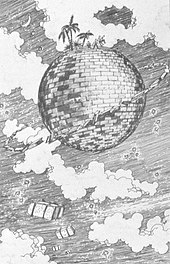
Space settlement
[edit]See also
[edit]References
[edit]- ^Clark, Stephen."Chinese astronaut launch breaks record for most people in orbit – Spaceflight Now".Retrieved1 June2023.
- ^abMann, Adam (January 25, 2012)."Strange Forgotten Space Station Concepts That Never Flew".Wired.RetrievedJanuary 22,2018.
- ^ab"The First Space Station".Boys' Life.September 1989. p. 20.
- ^"Science: Sun Gun".Time.July 9, 1945. Archived fromthe originalon May 21, 2013.RetrievedSeptember 13,2011.
- ^"Project Olympus (1962)".WIRED.2013-09-02.Retrieved2023-10-12.
- ^abIvanovich, Grujica S. (2008).Salyut – The First Space Station: Triumph and Tragedy.Springer Science+Business Media.ISBN978-0-387-73973-1.OCLC304494949.
- ^abChladek, Jay (2017).Outposts on the Frontier: A Fifty-Year History of Space Stations.Clayton C. Anderson.University of Nebraska Press.ISBN978-0-8032-2292-2.OCLC990337324.
- ^Portree, D. S. F. (1995)."Mir Hardware Heritage"(PDF).NASA. Archived fromthe original(PDF)on 7 September 2009.Retrieved30 November2010.
- ^Hall, R., ed. (2000).The History of Mir 1986–2000.British Interplanetary Society.ISBN978-0-9506597-4-9.
- ^"History and Timeline of the ISS".Center for the Advancement of Science in Space.Archived fromthe originalon 25 February 2018.Retrieved8 February2018.
- ^"Mechanical and Aerospace Engineering"(PDF).Usu.edu.Retrieved2012-08-13.[permanent dead link]
- ^Zak, Anatoly (22 May 2009)."Russia 'to save its ISS modules'".BBC News.Retrieved23 May2009.
- ^Foust, Jeff (25 September 2017)."International partners in no rush regarding future of ISS".SpaceNews.Retrieved26 October2017.
- ^Kelly, Thomas; et al. (2000).Engineering Challenges to the Long-Term Operation of the International Space Station.National Academies Press. pp. 28–30.ISBN978-0-309-06938-0.
- ^Foust, Jeff (13 December 2023)."SpaceX yet to select launch pad for next Axiom Space private astronaut mission".SpaceNews.Retrieved13 December2023.
Ondler said in the briefing that the first of those modules is now scheduled to launch to the ISS at the end of 2026, about a year later than the company previously announced.
- ^"NASA selects Axiom Space to build commercial space station module".SpaceNews.2020-01-28.Retrieved2020-09-18.
- ^Barbosa, Rui (29 September 2011)."China launches TianGong-1 to mark next human space flight milestone".NASASpaceflight.
- ^Staff (1 April 2018)."Tiangong-1: Defunct China space lab comes down over South Pacific".BBC News.Retrieved1 April2018.
- ^Chang, Kenneth (1 April 2018)."China's Tiangong-1 Space Station Has Fallen Back to Earth Over the Pacific".The New York Times.Retrieved1 April2018.
- ^Dickinson, David (10 November 2017)."China's Tiangong 1 Space Station to Burn Up".Sky & Telescope.Retrieved8 February2018.
- ^Liptak, Andrew (20 July 2019)."China has deorbited its experimental space station".The Verge.Retrieved21 July2019.
- ^"China launches first module of new space station".BBC News.29 April 2021.
- ^January 2021, Mike Wall 07 (7 January 2021)."China plans to launch core module of space station this year".Space.Retrieved2021-05-04.
{{cite web}}:CS1 maint: numeric names: authors list (link) - ^Clark, Stephen."China to begin construction of space station this year – Spaceflight Now".Retrieved2021-05-04.
- ^"NASA's Gateway Program".NASA.12 June 2023.Retrieved13 December2023.
- ^Foust, Jeff (13 December 2023)."SpaceX yet to select launch pad for next Axiom Space private astronaut mission".SpaceNews.Retrieved13 December2023.
Ondler said in the briefing that the first of those modules is now scheduled to launch to the ISS at the end of 2026, about a year later than the company previously announced.
- ^"Russia to set up national orbital outpost in 2027 — Roscosmos".TASS.Retrieved2023-05-30.
- ^Jewett, Rachel (2 August 2023)."Voyager Space and Airbus to Form Joint Venture for Starlab Commercial Space Station".Via Satellite.Retrieved13 December2023.
- ^"Airbus et Voyager vont créer une coentreprise pour la construction d'une station spatiale".Boursorama(in French). 2023-08-02.Retrieved2024-07-03.
- ^"Starlab - A New-Era Space Destination".Starlab - A New-Era Space Destination.Retrieved2024-07-03.
- ^"Gravitics".gravitics.Retrieved2024-03-28.
- ^"Blue Origin andn Sierra Space Developing Commercial Space Station"(PDF).RetrievedNovember 6,2022.
- ^"Prime Minister reviews readiness of Gaganyaan Mission".
- ^"Prime Minister reviews readiness of Gaganyaan Mission".
- ^"India plans to launch space station by 2030".Engadget.June 16, 2019.RetrievedJune 18,2019.
- ^"ISRO Looks Beyond Manned Mission; Gaganyaan Aims to Include Women".
- ^"India eying an indigenous station in space".The Hindu Business Line.June 13, 2019.RetrievedJune 18,2019.
- ^"ISRO Chairman announces details of Gaganyaan, Chandrayaan-2 and Missions to Sun& Venus India to have its own space station, says Dr K Sivan".Press Information Bureau.13 June 2019.Retrieved18 June2019.
- ^"India planning to have own space station: ISRO chief".The Economic Times.
- ^"India's Space Exploration Roadmap"(PDF).UNOOSA.
- ^"India's own space station to come up in 5–7 years: Isro chief – Times of India".The Times of India.13 June 2019.Retrieved2019-06-13.
- ^Ahatoly Zak."Lunar Orbital Station, LOS".Russian Space Web.Retrieved11 February2012.
- ^Xinhua(28 April 2012)."Russia unveils space plan beyond 2030".english.cntv.cn.China Central Television.Archived fromthe originalon 6 October 2014.Retrieved2 April2018.
- ^Etherington, Darrell (2023-05-10)."Vast and SpaceX aim to put the first commercial space station in orbit in 2025".TechCrunch.Retrieved2023-05-10.
- ^"VAST Announces the Haven-1 and VAST-1 Missions. — VAST".vastspace.Retrieved2023-05-10.
- ^Foust, Jeff (2023-06-28)."Sierra Space describes long-term plans for Dream Chaser and inflatable modules".SpaceNews.Retrieved2023-07-12.
- ^As, Ganesh (2020-03-13)."Mir, the first modular space station".The Hindu.ISSN0971-751X.Retrieved2022-08-27.
- ^Williams, Matt; Today, Universe."Looking back at the Mir space station".phys.org.Retrieved2022-08-27.
- ^"State space corporation ROSCOSMOS |".Archived fromthe originalon 2021-06-27.Retrieved2020-06-26.
- ^Gebhardt, Chris (2016-05-11)."CRS-8 Dragon completes ISS mission, splashes down in Pacific".NASASpaceFlight.Retrieved2022-08-28.
- ^Bergin, Chris (2016-04-16)."BEAM installed on ISS following CRS-8 Dragon handover".NASASpaceFlight.Retrieved2022-08-28.
- ^Davis, Jason (2016-04-05)."All about BEAM, the space station's new inflatable module".planetary.org.The Planetary Society.Retrieved2022-08-28.
- ^Foust, Jeff (2022-01-21)."Bigelow Aerospace transfers BEAM space station module to NASA".SpaceNews.Retrieved2022-08-28.
- ^Chang, Kenneth (27 January 2014)."Beings Not Made for Space".New York Times.Retrieved27 January2014.
- ^"Space Settlements: A Design Study".NASA.1975. Archived fromthe originalon 31 May 2010.Retrieved10 February2018.
- ^Bell, Trudy E. (2007)."Preventing" Sick "Spaceships".Archived fromthe originalon 2017-05-14.Retrieved2017-07-12.
- ^"Basics of Space Flight Section II. Space Flight Projects".www2.jpl.nasa.gov.Retrieved2022-08-23.
- ^Brown, Michael J. I. (5 December 2017)."Curious Kids: Where does the oxygen come from in the International Space Station, and why don't they run out of air?".The Conversation.Retrieved2022-08-27.
- ^Russian Space Stations (wikisource)
- ^"Are there military space stations out there?".HowStuffWorks.2008-06-23.Retrieved2022-08-27.
- ^Hitchens, Theresa (2019-07-02)."Pentagon Eyes Military Space Station".Breaking Defense.Retrieved2022-08-27.
- ^"Mission STS-127".Canadian Space Agency.Aug 13, 2008.RetrievedOct 20,2021.
- ^Madrigal, Alexis."March 22, 1995: Longest Human Space Adventure Ends".Wired.ISSN1059-1028.Retrieved2022-08-27.
- ^abMagazine, Smithsonian; Zak, Anatoly."The Strange Trip of Soyuz T-15".Smithsonian Magazine.Retrieved2022-08-26.
- ^"NASA Adds Sierra Nevada's Dream Chaser To ISS Supply Vehicles".TechCrunch.15 January 2016.Retrieved2022-08-25.[permanent dead link]
- ^"First Dream Chaser vehicle takes shape".SpaceNews.2022-04-29.Retrieved2022-08-25.
- ^Clark, Stephen."Last in current line of Japan's HTV cargo ships departs space station – Spaceflight Now".Retrieved2022-08-25.
- ^Noumi, Ai; Ujiie, Ryo; Ueda, Satoshi; Someya, Kazunori; Ishihama, Naoki; Kondoh, Yoshinori (2018-01-08)."Verification of HTV-X resilient design by simulation environment with model-based technology".2018 AIAA Modeling and Simulation Technologies Conference.AIAA SciTech Forum. Kissimmee, Florida: American Institute of Aeronautics and Astronautics.doi:10.2514/6.2018-1926.ISBN978-1-62410-528-9.
- ^"Russia's position in space race above India but below US and China — RealnoeVremya".realnoevremya.Retrieved2022-08-25.
- ^"Orel, the russian capsule that will replace the Soyuz".Enkey Magazine.2020-07-16.Retrieved2022-08-25.
- ^"Orbital's Antares launches Cygnus on debut mission to ISS".NASASpaceFlight.2013-09-18.Retrieved2022-08-24.
- ^"Cygnus sets date for next ISS mission – Castor XL ready for debut".NASASpaceFlight.2014-10-08.Retrieved2022-08-24.
- ^"Progress cargo ship".russianspaceweb.Retrieved2022-08-25.
- ^"Progress MS – Spacecraft & Satellites".Retrieved2022-08-25.
- ^"Spaceflight mission report: Soyuz TM-32".spacefacts.de.Retrieved2022-08-25.
- ^Bergin, Chris (2016-10-30)."Soyuz MS-01 trio return to Earth".NASASpaceFlight.Retrieved2022-08-25.
- ^"SpaceX's debut Cargo Dragon 2 docks to Station".NASASpaceFlight.2020-12-06.Retrieved2022-08-24.
- ^Gebhardt, Chris (2021-01-11)."CRS-21 Dragon completes mission with splashdown off Tampa".NASASpaceFlight.Retrieved2022-08-24.
- ^Jenniskens, Peter; published, Jason Hatton (2008-09-25)."The Spectacular Breakup of ATV: One Final Experiment".Space.Retrieved2022-08-24.
- ^"Ariane 5 Launches Final ATV Mission to Station".SpaceNews.2014-07-30.Retrieved2022-08-24.
- ^Malik, Tariq (2009-09-10)."Japan Launches Space Cargo Ship on Maiden Flight".Space.Retrieved2022-08-24.
- ^Graham, William (2020-05-25)."HTV-9 arrives at ISS on final mission".NASASpaceFlight.Retrieved2022-08-24.
- ^"Space History Photo: Madeleine Albright & Daniel Goldin at STS-88 Launch".Space.2012-05-22.Retrieved2022-08-24.
- ^Howell, Elizabeth (2021-07-09)."The last voyage of NASA's space shuttle: Looking back at Atlantis' final mission 10 years later".Space.Retrieved2022-08-24.
- ^Clara Moskowitz(2012-05-22)."SpaceX Launches Private Capsule on Historic Trip to Space Station".Space.Retrieved2022-08-24.
- ^Clark, Stephen."With successful splashdown, SpaceX retires first version of Dragon spacecraft – Spaceflight Now".Retrieved2022-08-24.
- ^"China space station: Shenzhou-12 delivers first crew to Tianhe module".BBC News.2021-06-17.Retrieved2022-08-26.
- ^Davenport, Justin (2021-06-16)."Shenzhou-12 and three crew members successfully launch to new Chinese space station".NASASpaceFlight.Retrieved2022-08-26.
- ^Wall, Mike (2021-05-29)."China launches new cargo ship to Tianhe space station module".Space.Retrieved2022-08-26.
- ^Graham, William (2021-05-29)."China launches Tianzhou 2, first cargo mission to new space station".NASASpaceFlight.Retrieved2022-08-26.
- ^"China's unmanned Shenzhou 8 capsule returns to Earth".BBC News.2011-11-17.Retrieved2022-08-26.
- ^"China launches Shenzhou-11 crewed spacecraft".SpaceNews.2016-10-17.Retrieved2022-08-26.
- ^"NASA – NSSDCA – Spacecraft – Details".nssdc.gsfc.nasa.gov.Retrieved2022-08-26.
- ^"NASA – NSSDCA – Spacecraft – Details".nssdc.gsfc.nasa.gov.Retrieved2022-08-26.
- ^"Spaceflight Now | Mir | Space tug poised for launch to Russia's Mir station".spaceflightnow.Retrieved2022-08-26.
- ^"Spaceflight Now | Mir | Deorbiting space tug arrives at Russia's Mir station".spaceflightnow.Retrieved2022-08-26.
- ^abZak, Anatoly (2016-02-19)."Why Mir Mattered More Than You Think".Popular Mechanics.Retrieved2022-08-26.
- ^"When Atlantis Met MIR 25 Years Since STS-71".Coca-Cola Space Science Center.16 June 2020.Retrieved2022-08-26.
- ^"STS-91 Space Radiation Environment Measurement Program -TOP-".iss.jaxa.jp.Retrieved2022-08-26.
- ^Compton, W. D.; Benson, C. D. (January 1983)."SP-4208 LIVING AND WORKING IN SPACE: A HISTORY OF SKYLAB – Chapter 15".history.nasa.gov.Retrieved2022-08-26.
- ^Compton, W. D.; Benson, C. D. (January 1983)."SP-4208 LIVING AND WORKING IN SPACE: A HISTORY OF SKYLAB – Chapter 17".history.nasa.gov.Retrieved2022-08-26.
- ^"The USSR launches first space station crew".russianspaceweb.Retrieved2022-08-26.
- ^Reiter, T.(December 1996)."Utilisation of the MIR Space Station".In Guyenne, T. D. (ed.).Space Station Utilisation, Proceedings of the Symposium held 30 September – 2 October, 1996 in Darmstadt, Germany.Vol. 385. European Space Agency. Noordwijk, The Netherlands: European Space Agency Publications Division. pp. 19–27.Bibcode:1996ESASP.385.....G.ISBN92-9092-223-0.OCLC38174384.Retrieved2022-08-28.
- ^Witze, Alexandra (2020-11-03)."Astronauts have conducted nearly 3,000 science experiments aboard the ISS".Nature.doi:10.1038/d41586-020-03085-8.PMID33149317.S2CID226258372.
- ^Guzman, Ana (2020-10-26)."20 Breakthroughs from 20 Years of Science aboard the ISS".NASA.Retrieved2022-08-28.
- ^Kinard, W.; O'Neal, R.; Wilson, B.; Jones, J.; Levine, A.; Calloway, R. (October 1994)."Overview of the space environmental effects observed on the retrieved long duration exposure facility (LDEF)".Advances in Space Research.14(10): 7–16.Bibcode:1994AdSpR..14j...7K.doi:10.1016/0273-1177(94)90444-8.PMID11540010.
- ^Zolensky, Michael (May 2021)."The Long Duration Exposure Facility—A forgotten bridge between Apollo and Stardust".Meteoritics & Planetary Science.56(5): 900–910.Bibcode:2021M&PS...56..900Z.doi:10.1111/maps.13656.ISSN1086-9379.S2CID235890776.
- ^Harvey, Gale A; Humes, Donald H; Kinard, William H (March 2000)."Shuttle and MIR Special Environmental Effects and Hardware Cleanliness".High Performance Polymers.12(1): 65–82.doi:10.1088/0954-0083/12/1/306.ISSN0954-0083.S2CID137731119.
- ^Nicogossian, A. E.; Roy, S. (1999)."Transitioning from Spacelab to the International Space Station".In Wilson, A. (ed.).The 2nd European Symposium on Utilisation of the International Space Station: 16-18 November 1998, ESTEC, Noordwijk, the Netherlands.Vol. 433. European Space Agency. Noordwijk, Netherlands: ESA Publications Division, ESTEC. pp. 653–658.Bibcode:1999ESASP.433..653N.ISBN92-9092-732-1.OCLC41941169.Retrieved2022-08-28.
{{cite book}}:|journal=ignored (help) - ^Groh, K. D.; Banks, B.; Dever, Joyce A.; Jaworske, D.; Miller, Sharon K. R.; Sechkar, Edward A.; Panko, Scott R. (2009). "International Space Station Experiments (Misse 1–7)".S2CID54880762.
{{cite web}}:Missing or empty|url=(help) - ^Center, NASA's Marshall Space Flight (15 September 2021)."Marshall contributes to key Space Station experiment".The Redstone Rocket.Retrieved2022-08-28.
- ^abMcKinney, Richard L. (2005)."Space Habitats".InWestfahl, Gary(ed.).The Greenwood Encyclopedia of Science Fiction and Fantasy: Themes, Works, and Wonders.Greenwood Publishing Group. pp. 736–738.ISBN978-0-313-32952-4.
- ^abNicholls, Peter;Langford, David(2022)."Space Stations".InClute, John;Langford, David;Sleight, Graham(eds.).The Encyclopedia of Science Fiction(4th ed.).Retrieved2023-12-29.
- ^Nicholls, Peter;Langford, David(2021)."Space Habitats".InClute, John;Langford, David;Sleight, Graham(eds.).The Encyclopedia of Science Fiction(4th ed.).Retrieved2021-08-06.
- ^Stableford, Brian(2006)."Artificial satellite".Science Fact and Science Fiction: An Encyclopedia.Taylor & Francis. pp. 35–37.ISBN978-0-415-97460-8.
- ^Fries, Sylvia Doughty;Ordway, Frederick I. III(1987-06-01)."The Space Station From Concept to Evolving Reality".Interdisciplinary Science Reviews.12(2): 143–159.doi:10.1179/isr.1987.12.2.143.ISSN0308-0188.
Bibliography
[edit]- Chladek, Jay (2017).Outposts on the Frontier: A Fifty-Year History of Space Stations.University of Nebraska Press.ISBN978-0-8032-2292-2.
- Haeuplik-Meusburger:Architecture for Astronauts – An Activity based Approach.Springer Praxis Books, 2011,ISBN978-3-7091-0666-2.
- Ivanovich, Grujica S. (July 7, 2008).Salyut: the first space station: triumph and tragedy.Praxis. p.426.ISBN978-0-387-73585-6.
- Neri Vela, Rodolfo (1990).Manned space stations "Their construction, operation and potential application.Paris: European Space Agency SP-1137.ISBN978-92-9092-124-0.
External links
[edit]- Read Congressional Research Service (CRS) Reports regarding Space Stations
- ISS– onRussian News Agency TASSOfficialInfographic(in English)
- The star named ISS– on Roscosmos TV(in Russian)
- "Giant Doughnut Purposed as Space Station",Popular Science,October 1951, pp. 120–121; article on the subject of space exploration and a space station orbiting earth
Further reading
[edit]- Baker, David (2015).International Space Station: 1998-2011 (all stages): an insight into the history, development, collaboration, production and role of the permanently manned earth-orbiting complex.Sparkford, Yeovil, Somerset.ISBN978-0-85733-839-6.OCLC945783975.
{{cite book}}:CS1 maint: location missing publisher (link)



